Workshop Guide to Setting Up A Bike Lift
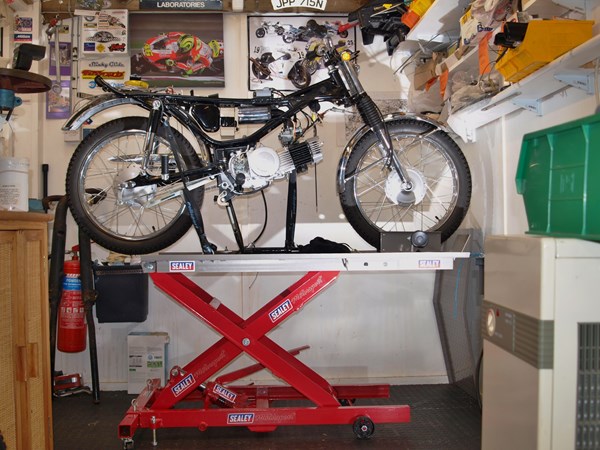
By Steve Cooper, VJMC Editor
You’re eighteen and your bike needs some work carried out to it; it’s not a major job but it requires some fettling. If you are really lucky you have access to your dad’s garage, if not it’s the garden path or the kerb side that will serve as your workshop. Inarguably you will also be working at ground level kneeling, stooping or lying down to gain access. This procedure, allied to the occasional roadside plug chop, will become so ingrained and automatic that you may very well be using this as your default for the rest of your life.
You’ll possibly acquire garages and workshops, but you’ll probably still be bending aged limbs until one day a light bulb illuminates and you finally give serious consideration to a proper bike lift…welcome to my world! Brutally hurtling towards a seventh decade my old bikes are actually in better physical shape than their owner. So here I am thinking "why work off the floor when the floor can come to me?”
A bike lift with some form of lifting mechanism is a thing of pure joy, yet until you’ve used one, you might very well scoff at the idea but think on. We bend to a good degree but there are limits to knees and hips; hydraulics are not so encumbered.
If you need simple access to a particular part of your bike this is now readily achievable, and when you sit on that old office chair in the shed and have the contact breakers staring you in the eye, life is suddenly so much easier. You are now able to focus solely on the job at hand and all your effort is directed to the task, with nothing held back for contorting your body at crazy angles. Goodbye, tomorrow’s aches and pains, hello several consecutive days in the workshop.
No two working areas are the same and no two shed dwellers have the same requirements. Each set of spannering criteria will be different, but hopefully, there’s a bike lift out there for most of us. Surfing the net shortlisted those that should suit most of my needs, and arch CMM supporters Sealey Tools kindly came up with the ideal match for my personal circumstances. What follows is an overview of how to install a bike lift and what to look out for. These devices are by their very nature heavy, so you really only want to move it the once. Forward and thorough planning is the order of the day.
The RD350 quakes in terror thinking it’s first on the operating table! Most lifts arrive boxed and on a pallet so ask the courier to get the lift as close as possible to its intended place of residence. 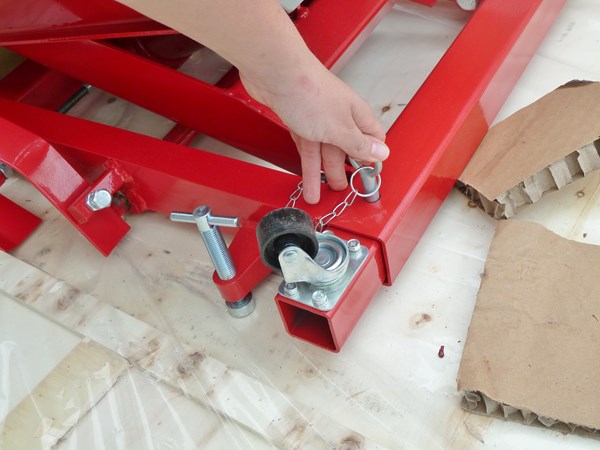
Read the instructions and assume nothing. The lift has been packed to minimise space and the sliding jockey wheels and support bars are the wrong way up. Five minutes spent now will make the install easier.
Most bike lifts have wheels so use them to your advantage. There’s a lot of weight in bike lift so don’t lift unless you need to. The packaging makes a decent covering for lawns and the like whilst manoeuvring.
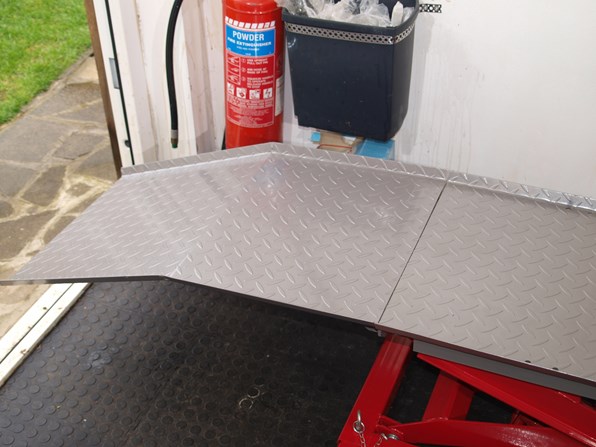
The ramp on this lift is demountable, making installation and use easier in smaller areas. Always ensure the ramp is securely attached or it will end in tears!
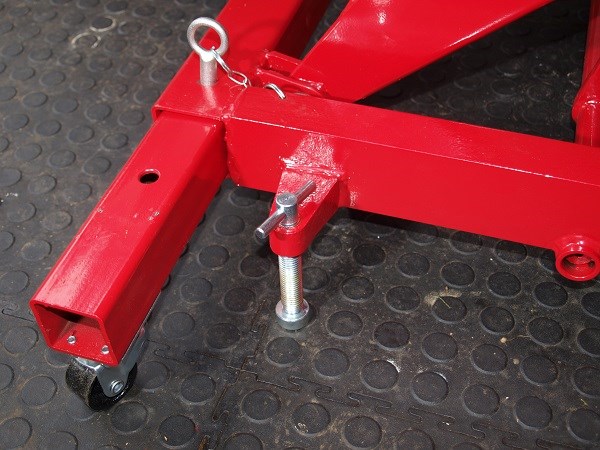
Safety-critical items. The jockey wheel outriggers are always best used extended to stabilise the load i.e. the bike. The turn screw should be used to ensure the bike lift is unable to roll across the workshop floor.
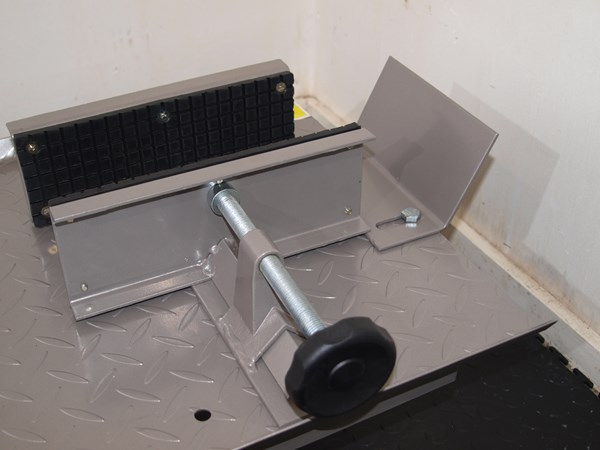
The angled plate stops the bike being pushed off the end…obviously. The clamp is an optional extra on some lifts and one worth having. Gripping a bike’s wheel adds an extra level of security. 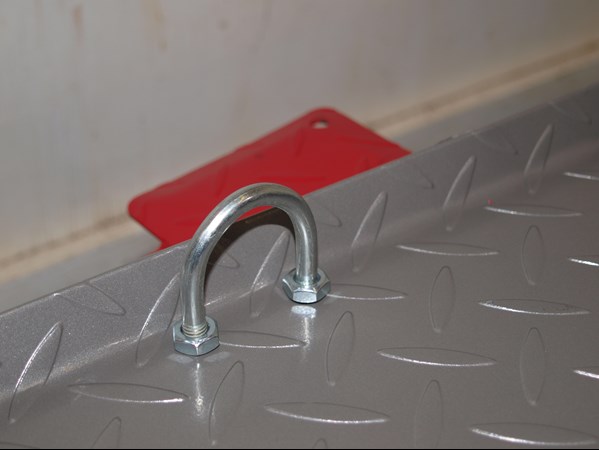
U bolts are a must have and should always be fitted and used when a bike is on the lift. They provide vital triangulation points when used in conjunction with tie-downs.
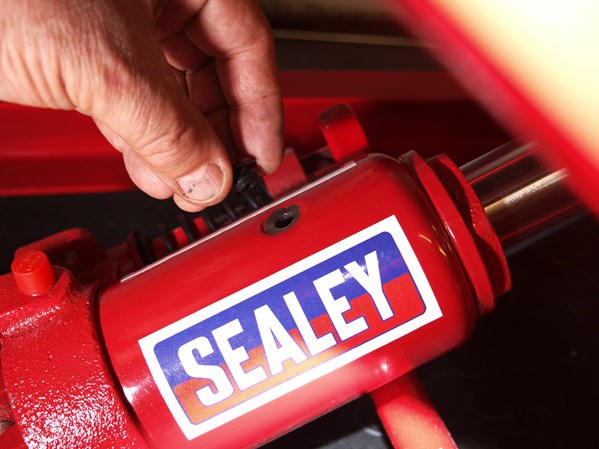
Hydraulic rams need to breathe so the rubber transit plug has to come out. The fluid inside may have become aerated in transit so follow the instructions on how to sort this or operation may be seriously compromised.
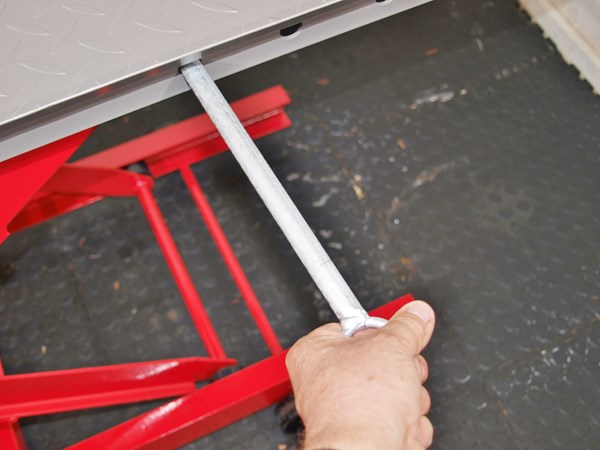
Any bike lift worth having will come with a table lockout bar. This is what takes the bike’s weight and ensures the table won’t collapse. Although the hydraulics do the work it makes sense not to perpetually strain their seals.
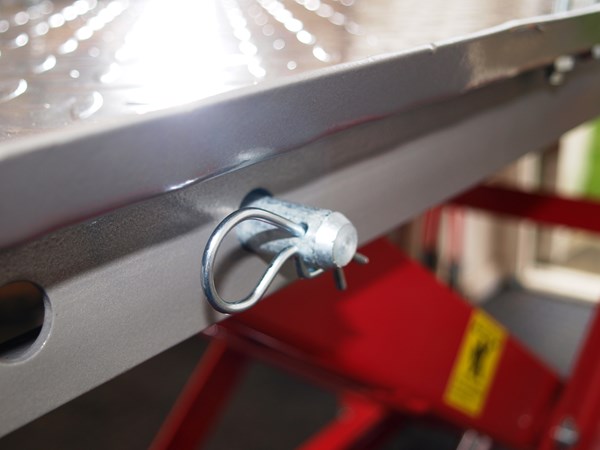
The opposite side of the table lockout bar should always be secured with an R clip or similar to ensure the bar is nor accidentally knocked out of dislodged. And in operation Project Stinger sits happily on its new perch ready for its loving owner (!) to get off his butt and do some spannering. Tie downs secure the bike against the owner’s stupidity. When not required, the loading ramp is stored securely against the wall of the workshop with a length of rope and a pair of screw eyes.
From here on in it’s a case of familiarising yourself with the lift’s operation, capabilities and limitations. Spend time getting comfortable with the raising and lowering controls making sure you can control the table’s descent before chancing a bike on it.
And this next bit is truly amazing…in the few weeks the Sealey bike lift has been in my workshop, it’s transformed my working practices, gained me valuable floor space, taken a lot of graft out of even the simplest of tasks and most importantly silenced the groaning noises I used to perpetually make.
My prejudice towards bike lifts had always been based around a skewed perspective that they’d take up to much space but in fact, I now have more elbow room than before. I’m a huge fan of my toy and my thanks go to Sealey for their help, support and enthusiasm. If us old grey beards are to continue spannering we need every workshop mod-con we can possibly obtain!
Selecting a bike lift
Paw through the motorcycle magazines, surf the web and you’ll find a bewildering array of bike lifts of every size and shape imaginable. Key Point No.1 has to be…will it fit in my garage/shed/workshop? The lift’s footprint is the absolute minimum space you’ll need but you’ll also need to add in room to access the bike. Overhanging shelves, garage or shed doors and the available roof height all need to be considered.
Next check that the lift you intend to buy raises straight up vertically and not upwards and at an angle; if it does then you’ll need to dial that into the equation. Having established all of that, work out what you’ll be putting on the lift in terms of size and mass.
If you’ll never own a Gold Wing do you really need a bike lift that can handle one? Conversely, a lightweight lift is likely to be a serious hazard if you overload it. Buying the first example you find because it’s cheap, and you may end up with a white elephant, but select carefully and the bike lift will become as indispensable as a set of spanners or an impact driver.
Safety and maintenance
A bike lift shouldn’t really require too much owner input but it pays to make the occasional checks. Mounting bolts and fixings need to be secure and it’ll never hurt to oil the pivot points. Any sign of oil leakage from the hydraulics should be investigated immediately. No one wants a bike landing on them from three foot high!
Always use the turn screws to prevent the lift being inadvertently moved across the floor and use the stabiliser bars at the maximum span for added stability. The table locking bar should always be used even on a five-minute job; hydraulic rams rarely fail but when they do your hands and feet don’t want to be in the vicinity!
If the lift is being used in a damp environment always lower the bench so that the ram body is protected from potential corrosion or you may end up with a damaged seal or fluid leaks. Finally, don’t trust a bike to sit on a raised bench unsecured. Numerous unhappy owners have turned their backs for a second or opened a shed door the next morning to find a bike fallen off a bike lift. A pair of tie downs is really cheap insurance when compared to repairing a dented NOS tank!
For more technical advice, visit Motorcycle Workshop Guides: The Complete List.
To find out more about a classic bike policy from Footman James and to get to an instant quote online, visit our Classic Bike Insurance page.
The information contained in this blog post is based on sources that we believe are reliable and should be understood as general information only. It is not intended to be taken as advice with respect to any specific or individual situation and cannot be relied upon as such.

COMMENT